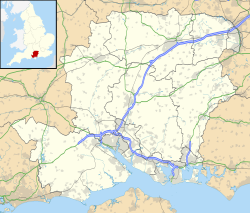RAF Sopley
| RAF Sopley | |
|---|---|
| Located near Sopley in Hampshire | |
| Type | Radar Centre |
| Site information | |
| Owner | Ministry of Defence |
| Controlled by | Royal Air Force |
| Site history | |
| Built | 1942 |
| In use | 1943-1974 |
RAF Sopley was a World War II airbase, codenamed Starlight, near the village of Sopley in Hampshire. The Radar Station was opened in December 1940. In 1959 it became an air traffic control radar station, and finally closed on 27 September 1974. Nearby Sopley Camp was built in the early 50's as a domestic site for the radar station and is probably best known as the initial home of the Vietnamese Boat People, in 1979. The camp was sold in 1993 to a local partnership under the name Merryfield Park. Most of the old barracks site had been redeveloped as housing, but the 2-storey building at the Sopley end has been converted into a museum/education centre by Friends Of New Forest Airfields (FONFA). The museum opened in May 2016.
History

The site started out as a Ground Controlled Interception (GCI) radar station. Its purpose to detect, locate and track enemy aircraft and provide inland radar coverage for Britain. Initially a mobile station, by 1943 it was a permanent fixture with rotating ariel array, transmitter equipment stored in an underground bunker, operations block, emergency back up power supply and guard hut.
In 1943 an Advanced Landing Ground called RAF Winkton was constructed to the southeast of the radar station.[1] RAF Winkton operated for less than a year and was officially closed in January 1945.[2]
In 1946 RAF Sopley was re-classified as a master GCI station and reserve Sector Operations Centre. As part of the UK's programme to update its air defences, Sopley underwent much modernisation during the 1950s including a new guardhouse providing access to a two storey underground operations centre. It was also in the early 50's that the domestic camp was built near Bransgore. In 1958 the School of Fighter Control moved in and from 1959 an Air Traffic Control Research Unit was established. The Fighter Control School disbanded in 1960 and the station taken over by Air Traffic Control. RAF Sopley fulfilled a number of other roles before closing in September 1974. The two level operations bunker was modernised in the 1970s when it was occupied by a Royal Signals unit from Signals Research and Development Establishment at Christchurch. The entire site transferred to the army soon after and for the duration of the Cold War was used by 2 Signals Brigade from the UK Land Forces at Wilton. The only surviving surface features of the site are the guardhouse, which has been refurbished, the generator building and a small blockhouse that doubles as an emergency exit for the bunker. The bunker too remains intact and is used by a private company for data storage.[3]
References
- ^ Starlight, Southern Radar and RAF Sopley
- ^ Winkton Advanced Landing Ground
- ^ "RAF Sopley". PastScapes. English Heritage. Retrieved 6 June 2011.

